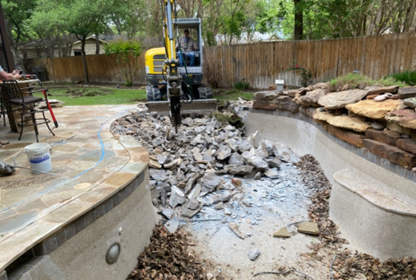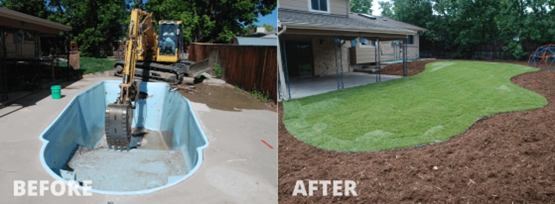Why Should You Consider Removing a Swimming Pool?
Removing a swimming pool can provide multiple benefits, whether you're looking to cut costs or change the layout of your yard. Pool maintenance can be expensive, requiring regular cleaning, water treatment, and equipment upkeep. By removing your pool, you can eliminate these ongoing costs. Additionally, the space that the pool occupies can often limit other possibilities for landscaping or development. Whether you want to create a lush garden, a larger patio area, or even build a new structure, removing the pool allows for greater flexibility in design. Furthermore, removing an underused pool can increase your property’s appeal to prospective buyers, especially those who do not want the added responsibility of pool maintenance.
What Are the Different Methods to Remove a Swimming Pool?
Step-by-Step Guide: How to Remove a Swimming Pool
Step 1: Assessing the Pool and Planning the Removal
Before removing your pool, it’s crucial to assess the condition of the pool and decide on the appropriate removal method. If you're looking for a quick and cost-effective solution, partial removal might be the best choice. However, for a cleaner outcome, especially if you're planning to use the space for something else, full removal is often recommended. It’s advisable to consult with a professional to inspect the pool’s structure and identify potential challenges. A demolition expert can also guide you through the permitting process and ensure that all legal requirements are met. Planning is essential to avoid unexpected delays and ensure the process runs smoothly.

Step 2: Draining the Pool and Removing Water Features
Draining the pool is the first physical step in the removal process. You can do this using a submersible pump or the pool's built-in drainage system. Be sure to remove all water before beginning demolition, as water left in the pool can cause complications and delay the process. Once the pool is drained, remove all water features like ladders, diving boards, handrails, and lights. This is essential to ensure nothing interferes during the demolition phase. Carefully remove each piece to avoid damage and make sure the area is clear for the heavy equipment that will be used in the next phase of the removal.
Step 3: Demolition and Excavation
Demolition of the pool involves breaking down the structure with heavy machinery such as jackhammers or excavators. Concrete is typically the most difficult material to break down, so it requires thorough handling. Start by breaking up the pool's deck and outer walls, making sure to dispose of any debris as you go. Excavators will help to remove the bulk of the material, including the concrete and rebar. It’s crucial to ensure all materials are removed, including smaller pieces that could cause problems later. Professional supervision is recommended during this stage to ensure safety and prevent accidents from occurring. Proper demolition sets the stage for a smooth fill process.
Step 4: Filling the Hole and Landscaping
After demolition, the next step is to fill the hole left by the pool. The filling process involves layering gravel and soil in the hole. Each layer must be compacted to avoid settling in the future, which can cause uneven ground. Depending on the intended use of the space, you can add topsoil for planting, or simply compact the fill material for a solid surface suitable for landscaping or other structures. Once the hole is filled, you can start transforming the area into something new. Whether you choose to plant a garden, build a patio, or add other structures, the removed pool space will now become a usable and versatile part of your yard.
Common Mistakes to Avoid When Removing a Swimming Pool
When removing a swimming pool, it’s essential to avoid common mistakes that can lead to delays, increased costs, or safety hazards. One common mistake is failing to secure the necessary permits before starting the removal process. Not having the right permits can result in fines or even the need to stop the work until approval is obtained. Another mistake is improper drainage, which can lead to flooding and damage to the surrounding property. Skipping safety protocols during excavation is another issue that can cause accidents. Finally, not compacting the fill material properly can lead to settling, creating an uneven yard surface in the future.
How Much Does It Cost to Remove a Swimming Pool?
The cost of removing a swimming pool can vary significantly based on factors such as pool size, location, and removal method. On average, partial pool removal costs between $2,000 and $10,000. This method is less expensive because it only involves demolishing part of the pool and filling it with rubble. However, full pool removal, which involves completely demolishing and removing all pool materials, is more expensive, with costs ranging from $5,000 to $15,000. Additional costs, such as obtaining permits, hauling away debris, and landscaping, can add to the total price. To get an accurate estimate, it’s important to get quotes from multiple contractors.
Conclusion
Removing a swimming pool is a significant decision that opens up many possibilities for transforming your yard. Knowing how to remove a swimming pool is essential for making the most of this change. With the right planning and execution, pool removal can enhance the usability and value of your property. Whether you're looking to reduce maintenance costs, repurpose the space for a new purpose, or simply make your property more appealing, understanding the entire removal process will make the task easier. By following the steps outlined, you can ensure a smooth and successful pool removal. With careful planning and professional assistance, your yard will be ready for new projects in no time.
FAQ:
Do I need a permit to remove a swimming pool?
Yes, most local governments require a permit for pool demolition. Check with your city or county’s building department to ensure all legal aspects are covered.
What is the best time of year to remove a swimming pool?
The best time for pool removal varies depending on your region, but generally, spring and summer are ideal. Dry weather conditions make the demolition process smoother and prevent complications related to ground moisture.
What happens to the debris after a pool is removed?
Typically, contractors dispose of the debris according to local regulations. Concrete, metal, and other materials are hauled away to be recycled or sent to landfills. Ensure your contractor plans appropriate disposal to avoid environmental issues.

